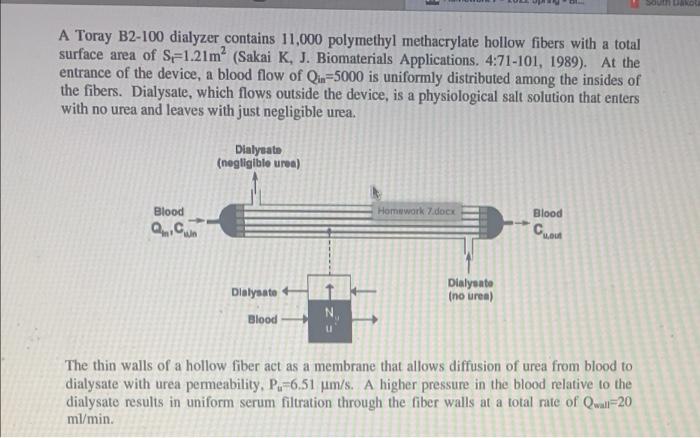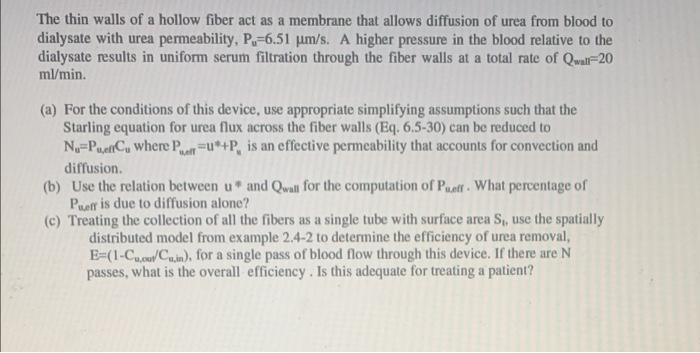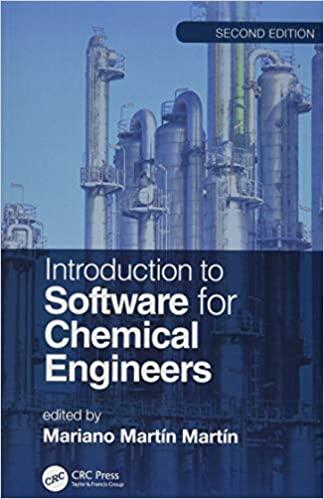please solve these:
here is equation 6.5.30
here is example 2.4-2
A Toray B2-100 dialyzer contains 11,000 polymethyl methacrylate hollow fibers with a total surface area of S=1.21m2 (Sakai K, J. Biomaterials Applications. 4:71-101, 1989). At the entrance of the device, a blood flow of Qin=5000 is uniformly distributed among the insides of the fibers. Dialysate, which flows outside the device, is a physiological salt solution that enters with no urea and leaves with just negligible urea. Dialysato (negligible uren) Homework 7.docx Blood Blood Qu.cn Co Dialysate + Dialysate (no urea) Blood The thin walls of a hollow fiber act as a membrane that allows diffusion of urea from blood to dialysate with urea permeability, P.-6.51 m/s. A higher pressure in the blood relative to the dialysate results in uniform serum filtration through the fiber walls at a total rate of Qwall=20 ml/min. The thin walls of a hollow fiber act as a membrane that allows diffusion of urea from blood to dialysate with urea permeability, P.-6.51 um/s. A higher pressure in the blood relative to the dialysate results in uniform serum filtration through the fiber walls at a total rate of Qwali=20 ml/min. (a) For the conditions of this device, use appropriate simplifying assumptions such that the Starling equation for urea flux across the fiber walls (Eq. 6.5-30) can be reduced to Ng= PC, where Pair=u*+P, is an effective permeability that accounts for convection and diffusion (b) Use the relation between u and Qwall for the computation of Puff. What percentage of Puery is due to diffusion alone? (c) Treating the collection of all the fibers as a single tube with surface area S, use the spatially a distributed model from example 2.4-2 to determine the efficiency of urea removal, E=(1-C.com), for a single pass of blood flow through this device. If there are N passes, what is the overall efficiency. Is this adequate for treating a patient? N= u'Cave (1-0) + P, ACs d(Ci,out V.) dt Qin Ci, in - Qout Cijout - Ni , wall + - A Toray B2-100 dialyzer contains 11,000 polymethyl methacrylate hollow fibers with a total surface area of S=1.21m2 (Sakai K, J. Biomaterials Applications. 4:71-101, 1989). At the entrance of the device, a blood flow of Qin=5000 is uniformly distributed among the insides of the fibers. Dialysate, which flows outside the device, is a physiological salt solution that enters with no urea and leaves with just negligible urea. Dialysato (negligible uren) Homework 7.docx Blood Blood Qu.cn Co Dialysate + Dialysate (no urea) Blood The thin walls of a hollow fiber act as a membrane that allows diffusion of urea from blood to dialysate with urea permeability, P.-6.51 m/s. A higher pressure in the blood relative to the dialysate results in uniform serum filtration through the fiber walls at a total rate of Qwall=20 ml/min. The thin walls of a hollow fiber act as a membrane that allows diffusion of urea from blood to dialysate with urea permeability, P.-6.51 um/s. A higher pressure in the blood relative to the dialysate results in uniform serum filtration through the fiber walls at a total rate of Qwali=20 ml/min. (a) For the conditions of this device, use appropriate simplifying assumptions such that the Starling equation for urea flux across the fiber walls (Eq. 6.5-30) can be reduced to Ng= PC, where Pair=u*+P, is an effective permeability that accounts for convection and diffusion (b) Use the relation between u and Qwall for the computation of Puff. What percentage of Puery is due to diffusion alone? (c) Treating the collection of all the fibers as a single tube with surface area S, use the spatially a distributed model from example 2.4-2 to determine the efficiency of urea removal, E=(1-C.com), for a single pass of blood flow through this device. If there are N passes, what is the overall efficiency. Is this adequate for treating a patient? N= u'Cave (1-0) + P, ACs d(Ci,out V.) dt Qin Ci, in - Qout Cijout - Ni , wall +










